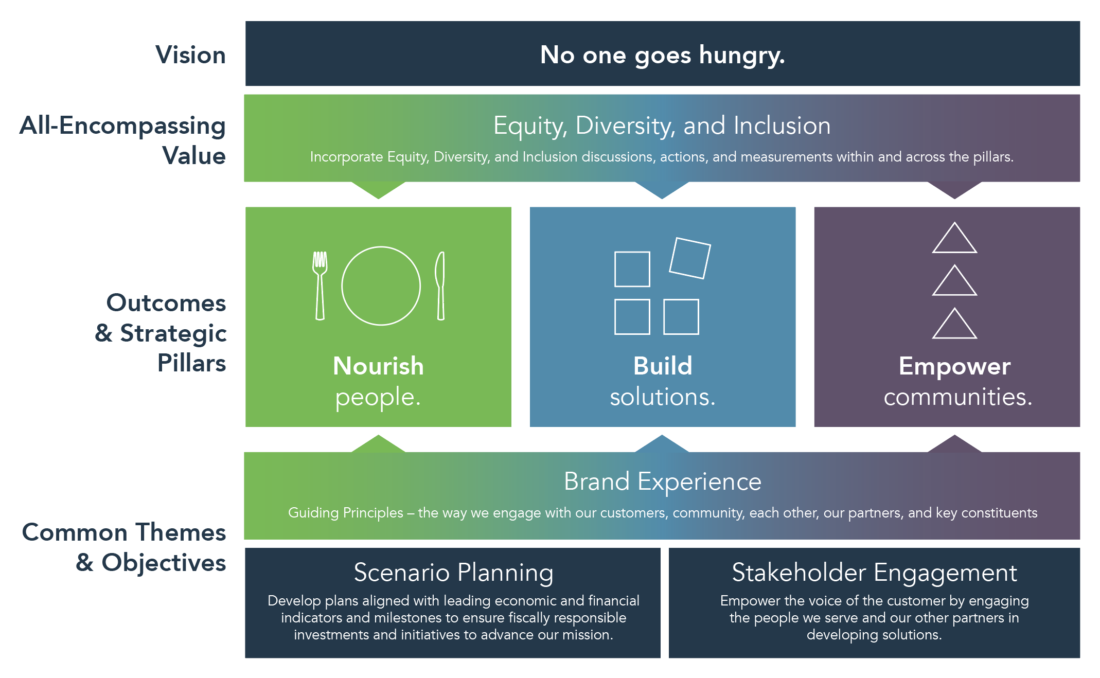Fiscal Year 2021-2024 Strategic Plan

We’ve known for some time that the Food Bank’s next strategic plan would need to be informed by an in-depth look at what’s next in fighting hunger and building a path to food security. But we could not have anticipated the incredible impact the COVID-19 pandemic has had for the people and communities we serve.
COVID-19 shed light on an issue we’ve known was there—so many members of our community are living one health crisis, one missed paycheck, and one grocery store trip away from needing to use the Food Bank network. While we have witnessed and experienced unprecedented need, we have also experienced unprecedented support. The community has developed a greater awareness of food insecurity, of how many families and individuals live so close to the edge in putting food on the table.
With this strategic plan, we have an opportunity, and a responsibility, to look deeper and develop approaches to support people on the cusp of food insecurity before they find themselves needing the services of the hunger relief system.
By prioritizing equity, diversity, and inclusion; nourishing people; building solutions; and empowering communities, we’re being innovative: building on and strengthening our tactics that will move the needle toward food security in our communities, ultimately realizing our vision of no one going hungry
EQUITY, DIVERSITY, AND INCLUSION LENS
Focus Areas:
- Challenge systems of inequity through our work.
- Maintain an inclusive environment in which all employees can work, thrive, and be respected and valued as their full selves.
- Attract, recruit, retain, and invest in the development of a diverse workforce.
- Address the needs of all community partners through culturally relevant and enriching practices.
- Educate, partner with, and empower our stakeholders with communication and practices that align with the Food Bank’s equity, diversity, and inclusion values.
- Engage with community members and groups to address the needs of diverse populations and work to end the root causes of food insecurity.
Outcome: Improve equity, diversity, and inclusion by creating an equity lens through which we communicate and operate.
THE NOURISH PILLAR
THE NOURISH PILLAR
Focus Areas:
- Efficiency
- Equity in service
- Innovation
Initiatives:
- Closing last mile gaps with direct distributions to get the right food to people at the right time, in rural areas and in times of disaster.
- Improving our infrastructure with new facilities, better warehouse technology, and additional program staff, all of which will increase efficiency.
- Investing in local agriculture vendors, to find innovative ways of strengthening food systems and getting food directly to partner agencies.
Outcome: Increased access to and distribution of nutritious food that is culturally appropriate, reduces waste, and strengthens the food systems in our community.
THE BUILD PILLAR
Focus Areas:
- People
- Technology
- Sustainable funding
Initiatives:
- Assessing our technology infrastructure, and strategically improving available resources.
- Implementing a data analytics program to analyze trends and create best practices.
- Strengthening workforce planning and management programs to hire and retain talented staff.
Outcome: Supported and well-resourced workforce and network of partners able to build sustainable solutions to ending hunger.
THE EMPOWER PILLAR
Focus Areas
- Supporting whole individuals
- Resources to strengthen communication
- Removing barriers
Initiatives:
- Focusing on economic empowerment through workforce development programs that not only build skills but support hunger relief work.
- Piloting programs around mental health and wellness, collaborating with partners to support root cause work.
- Creating community impact programs, on a very targeted level, to assess needs and impact—which could then be expanded.
- Using the brand of the Food Bank to empower our partners and increase education and understanding of food insecurity.
Outcome: Forward-looking and collaborative roadmap to address root causes of hunger, elevating hunger relief work to the next level of service.

